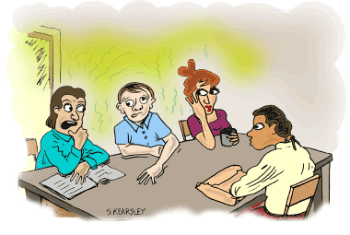|
Monthly
Feature:


It was a dinner long remembered for a special casserole, one made of seven
different types of dried beans. It was a delicious amalgam
of flavors, for those beans had been basking in the oven for
hours. Its after-effects, however, lingered well beyond the
meal.
The following evening when the host was asked about his
day, he shyly confessed, "I was scared to leave my office."
Apparently it had been a hugely "windy day" ... with intestinal
gas and mortifying consequences. He even swore that each bean
was on a different frequency! Though we've been unable to
substantiate through relevant research studies, the accuracy
of the latter portion of his account, his experience did confirm
the reputation of dried beans as a "musical fruit."
We learned several things from that dinner. One was that
in some ways life doesn't change. What we now call "flatulence"
has been of social concern since Victorian times. Then, it
was delicately known as "windinesse." Generations later, intestinal
gas still manifests itself when certain foods, such as baked
beans, are consumed.
Swallowing air as you eat and eating too fast, two obvious culprits, lead to the accumulation of gas in the upper digestive tract. The other major contributor is the bacterial fermentation of undigested food that takes place in the lower intestine.
It's quite normal to generate intestinal gas, on average one to three pints a day. Most intestinal gases are composed of carbon dioxide, hydrogen, nitrogen, and sometimes methane, and these have no odor. It's the smelly sulfur-containing compounds that cause the fuss.
Foods that cause gas for one person may not affect another. There are some
commonly recognized offenders, however, such as lactose (milk
sugar), the soluble fibers in fruits, some sugarless gum,
and carbonated beverages.
But the most infamous sources of gas in food are likely the oligosaccharides. These are short molecular chains of sugars that have been stored in large amounts in the outer coatings of legumes, nuts and seeds, and in much smaller amounts in other vegetables and grains. Of the dried legumes, navy beans and lima beans reportedly cause more gas than other varieties.
Baked beans may even carry a double whammy when they're made with beer. Dark
ales, especially, are also offenders. When starches, fibers,
and sugars pass the stomach and small intestine without being
broken down or absorbed by digestive enzymes, they reach the
lower intestine intact. There, they're vigorously attacked
by colonies of harmless bacteria, producing offending gases
as waste products.
If you're bothered by flatulence, here are four ideas that might help control emissions.
-
A most sensible tactic involves a lengthy soaking, and was developed
some years ago by the California Dry Bean Advisory Board.
For each pound of dried beans, use ten or more cups of boiling
water. Boil for two to three minutes, cover, and set the
beans aside overnight. This initial boiling breaks down
the cell membranes of the beans, releasing the oligosaccharides
so they can dissolve into the soaking water. Just make sure
you discard the soaking water!
-
Cook beans well before adding any acidic ingredients like tomatoes or molasses, as acids prevent legumes from softening. When beans are softer, they're also more digestible.
-
Try an over-the-counter digestive aid, such as Beano, which contains the
sugar-digesting enzyme that the body lacks. Use Beano just
before eating so it can break down the gas-producing oligosaccharides.
It has no effect, however, on gas caused by lactose or fiber.
-
Try adding epazote (1 tablespoon to a large pot of chili,
beans, or soup). Epazote is the leaf of a wild herb, prized
for its gas-reducing abilities.
If you know of other suggestions that are successful in reducing intestinal gas, please add them to the Forum.
P.S. As to baked beans in Sue's family? We still enjoy them greatly, though we've not been brave enough to try seven-bean casserole since!
|
